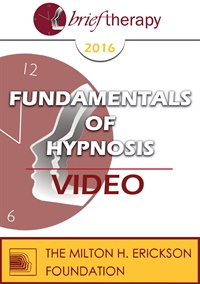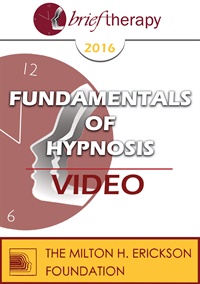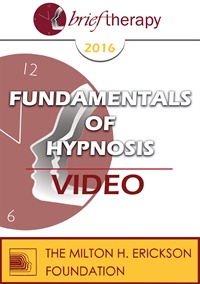
Credit available - Click Here for more information
- Average Rating:
- Not yet rated
- Topic Areas:
- Hypnosis | Advanced Techniques of Hypnosis & Therapy | Continuing Education | Ericksonian Hypnosis and Therapy Techniques | Hypnotherapy | Milton Erickson | Communication | Metaphors
- Categories:
- Advanced Techniques of Hypnosis & Therapy | Featured | Training Videos | Online Continuing Education | Milton H. Erickson Collections
- Faculty:
- Jeffrey Zeig, PhD | Milton H. Erickson, MD
- Course Levels:
- Master Degree or Higher in Health-Related Field
- Duration:
- 02:38:00
- Format:
- Audio and Video
- Original Program Date:
- Dec 31, 1977
- Short Description:
- This training tool contains segments of hypnotherapy conducted by Erickson, with the same subject, on two consecutive days in 1978. Erickson demonstrates how symbols may be used as metaphoric forms of communication to foster new ideas and understandings. Zeig discusses Erickson’s technique.
- Price:
- $75.00 - Base Price
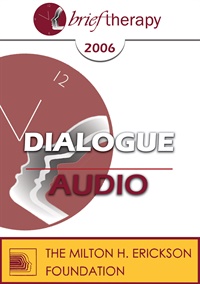
- Average Rating:
- Not yet rated
- Topic Areas:
- Dialogues | Metaphors | Brief Therapy | Ericksonian Hypnosis and Therapy Techniques
- Categories:
- Brief Therapy Conference | Brief Therapy Conference 2006
- Faculty:
- Jeffrey Kottler, PhD | Stephen Lankton, MSW
- Duration:
- 59:20
- Format:
- Audio Only
- Original Program Date:
- Dec 08, 2006
- Short Description:
- BT06 Dialog 02 - Metaphor - Jeffrey Kottler, PhD & Stephen Lankton, MSW, DAHB
- Price:
- $15.00 - Base Price
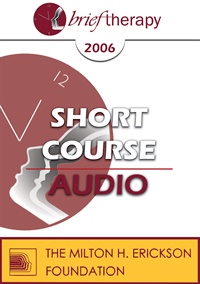
- Average Rating:
- Not yet rated
- Topic Areas:
- Short Courses | Brief Therapy | Dreamwork | Hypnosis | Metaphors | Trauma
- Categories:
- Brief Therapy Conference | Brief Therapy Conference 2006
- Faculty:
- Deborah Beckman
- Duration:
- 1:18:59
- Format:
- Audio Only
- Original Program Date:
- Dec 07, 2006
- Short Description:
- Dreaming is a vital, nightly function of the brain. Disturbing dreams or recurrent nightmares are frequent symptoms of an acute focus on unresolved conflicts and events. Clients can learn to reclaim comforting sleep even before the overt reasons for seeking therapy are directly addressed. The potential of individualized metaphors structured within lucid dreaming empowers clients to "seize" the night." Hypnotic techniques offer an intriguing path that bypasses a client's ingrained fear of "falling to sleep."
- Price:
- $15.00 - Base Price
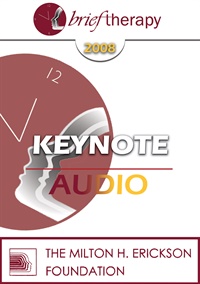
- Average Rating:
- Not yet rated
- Topic Areas:
- Keynotes | Brief Therapy | Habits | Metaphors
- Categories:
- Brief Therapy Conference | Brief Therapy Conference 2008
- Faculty:
- Joan Borysenko, PhD
- Duration:
- 59:33
- Format:
- Audio Only
- Original Program Date:
- Dec 12, 2008
- Short Description:
- BT08 Keynote 02 - The Soul's Compass - Joan Borysenko, PhDThere is no map for becoming a fully human being, but there is a soul's compass. Orienting to true north requires interior freedom, curiosity and moment -to-moment awareness. The means to uncovering these intrinsic aspects of self, and the blocks to their recognition, are intrinsic to all the world's wisdom traditions.
- Price:
- $15.00 - Base Price
Tags: Brief Therapy Habits Metaphors

- Average Rating:
- Not yet rated
- Topic Areas:
- Short Courses | Brief Therapy | Children and Adolescent Therapy | Communication | Metaphors
- Categories:
- Brief Therapy Conference | Brief Therapy Conference 2008
- Faculty:
- Marilyn Wedge
- Duration:
- 1:23:15
- Format:
- Audio Only
- Original Program Date:
- Dec 11, 2008
- Short Description:
- The language a therapist uses to conceptualize and treat a problem determines whether or not that problem can be resolved effectively. Plato's story of the cave, where the inhabitants see only shadows, is a useful metaphor for how the language of therapy can generate either confusion or clarity. This workshop will teach a method of effectively treating severe problems of children and adolescents, using an invariant opening question, strategic dialogue and metaphorical techniques.
- Price:
- $15.00 - Base Price
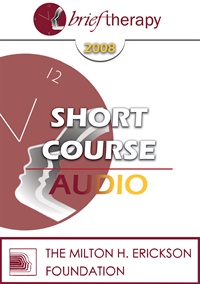
- Average Rating:
- Not yet rated
- Topic Areas:
- Short Courses | Communication | Metaphors | Brief Therapy | Reality Therapy
- Categories:
- Brief Therapy Conference | Brief Therapy Conference 2008
- Faculty:
- Robert Wubbolding, EdD
- Duration:
- 1:25:22
- Format:
- Audio Only
- Original Program Date:
- Dec 11, 2008
- Short Description:
- Practicality and usability occupy the center of the reality therapy WDEP process. This workshop emphasizes advanced application through the use of metaphors designed to help clients determine the realistic attainability of their wants and the efficacy of their behaviors. Adrian Monk and Lieutenant Columbo provide assistance to therapist and client as they walk the path, untangle the web, and bring the unknown to light.
- Price:
- $15.00 - Base Price
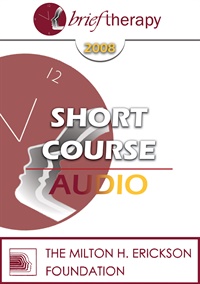
- Average Rating:
- Not yet rated
- Topic Areas:
- Short Courses | Brief Therapy | Goals of the Therapist | Metaphors | Therapist Development
- Categories:
- Brief Therapy Conference | Brief Therapy Conference 2008
- Faculty:
- Christine Guilloux, DESS Psychology
- Duration:
- 55:10
- Format:
- Audio Only
- Original Program Date:
- Dec 11, 2008
- Short Description:
- Subject, patient, client, therapist, teacher, trainer, supervisor, supervised; all of us are shaped from an essence, the stuff we are made of, the hero within. This workshop will offer ways to utilize our hidden heroes in our therapeutic goals for inner change, and help the patient build from the hero within him/herself.
- Price:
- $15.00 - Base Price
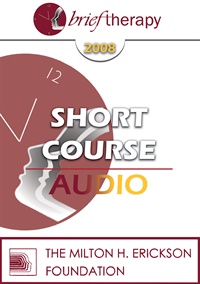
- Average Rating:
- Not yet rated
- Topic Areas:
- Short Courses | Metaphors | Trance | Brief Therapy | Communication
- Categories:
- Brief Therapy Conference | Brief Therapy Conference 2008
- Faculty:
- Betty Blue, PhD
- Duration:
- 1:10:52
- Format:
- Audio Only
- Original Program Date:
- Dec 11, 2008
- Short Description:
- This course will use theory, clinical examples, techniques, PowerPoint illustrations, quotations and experiential metaphorical fantasy to display how compassionately playful client-therapist interactions can serve to encourage transcendence from suffering, solution expansion and professionally appropriate intimacy while also discouraging states of maladaptive isolation.
- Price:
- $15.00 - Base Price
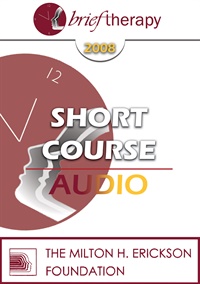
- Average Rating:
- Not yet rated
- Topic Areas:
- Short Courses | Depression | Reframing | Metaphors
- Categories:
- Brief Therapy Conference | Brief Therapy Conference 2008
- Faculty:
- Deborah Beckman
- Duration:
- 1:24:44
- Format:
- Audio Only
- Original Program Date:
- Dec 11, 2008
- Short Description:
- Disturbed sleep painfully contributes to depression. Paradoxically, client's symptoms become pathways that disarms suffering, yielding to the solace of sound sleep. Clients then pace healing to the rhythms of restorative sleep, without excess alarm. Ericksonian-based trance language directly addressing disturbed sleep first, and indirectly addressing depression will be offered.
- Price:
- $15.00 - Base Price
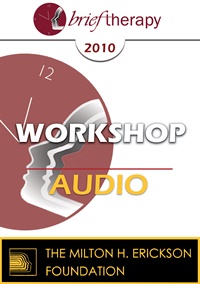
- Average Rating:
- Not yet rated
- Topic Areas:
- Workshops | Metaphors | Brief Therapy | Creativity in Therapy
- Categories:
- Brief Therapy Conference | Brief Therapy Conference 2010
- Faculty:
- Steve Andreas, MA, NLP
- Duration:
- 1:44:10
- Format:
- Audio Only
- Original Program Date:
- Dec 12, 2010
- Short Description:
- This workshop offers a hands-on way of working with stuckness through clients’ own metaphors of movement, space, and direction. By carefully exploring sensory detail and letting solutions emerge from within the image itself, it shows how perspective, grounding, and small shifts can open new paths forward without analysis, interpretation, or advice.
- Price:
- $15.00 - Base Price
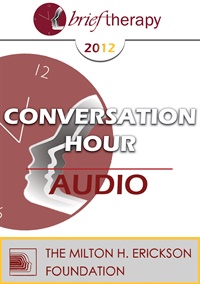
- Average Rating:
- Not yet rated
- Topic Areas:
- Couples Therapy | Hypnosis | Conversation Hours | Metaphors | Brief Therapy
- Categories:
- Brief Therapy Conference | Brief Therapy Conference 2012
- Faculty:
- Wendel Ray, PhD
- Duration:
- 52:29
- Format:
- Audio Only
- Original Program Date:
- Dec 07, 2012
- Short Description:
- BT12 Conversation Hour 11 – 1956 Flashback: Hypnosis, Paradox, Metaphorical Tasks & The Invention of Brief Couples Therapy – Wendel Ray, PhD Educational Objectives: Learn the philosophies of various practitioners and theorists.
- Price:
- $15.00 - Base Price
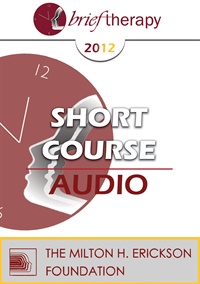
- Average Rating:
- Not yet rated
- Topic Areas:
- Short Courses | Metaphors | Therapist Development
- Categories:
- Brief Therapy Conference | Brief Therapy Conference 2012
- Faculty:
- Robert Staffin, PsyD, ABPH
- Duration:
- 1:04:00
- Format:
- Audio Only
- Original Program Date:
- Dec 05, 2012
- Short Description:
- If you have ever felt like it would be nice to have a script or metaphor to facilitate the progress of a client in therapy, this course is for you. Participants will learn how to utilize their own interest, skills and abilities to create interventions tailored to their clients.
- Price:
- $15.00 - Base Price
Tags: Metaphors
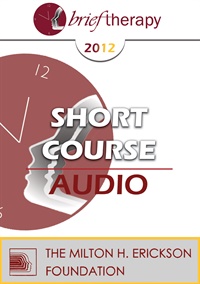
- Average Rating:
- Not yet rated
- Topic Areas:
- Animal Assisted Therapy | Psychotherapy | Short Courses | Metaphors | Brief Therapy
- Categories:
- Brief Therapy Conference | Brief Therapy Conference 2012
- Faculty:
- Dale Klein-Kennedy, LPCC | Karen Wall
- Duration:
- 1:07:50
- Format:
- Audio Only
- Original Program Date:
- Dec 09, 2012
- Short Description:
- Animal metaphors are used as a part of our everyday vocabulary describing relationships, personal characteristics, etc. Metaphor in the presence of the work with the animal takes on a new and deeper meaning. This presentation will demonstrate the powerful use of animals and animal metaphors in brief psychotherapy. Through examples and discussion of the work, attendees will develop an understanding of ATT (animal-assisted therapy) and will participate in a live demonstration of AAT.
- Price:
- $15.00 - Base Price
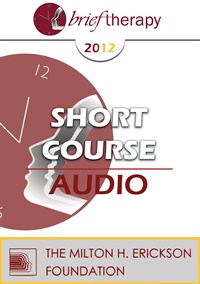
- Average Rating:
- Not yet rated
- Topic Areas:
- Hypnosis | Short Courses | Metaphors | Brief Therapy
- Categories:
- Brief Therapy Conference | Brief Therapy Conference 2012
- Faculty:
- Bette Freedson, MSW
- Duration:
- 1:14:37
- Format:
- Audio Only
- Original Program Date:
- Dec 09, 2012
- Short Description:
- Therapists working with single mothers often hear stories of abandonment, disempowerment, loneliness, hopelessness, victimization, rage and unrelenting stress. Disturbing perceptions and emotions such as these, and the distorted interpretations that result, may rigidify into psychic schemas comprised of patterns of dysfunctional reacting and compromised coping. Identifying negative schemas, and harnessing the mind’s powerful potential to transform them, will be the dual focus of this course. Participants will explore the way in which the quiet mind, combined with the evocative and rhythmic language of hypnosis, can fuel a subconscious shift from confusion to clarity. Participants will experience the way in which sympathetic identification with transformed metaphors, drawn from the substance of personal stories, can fuel an alchemical shift that decreases stress, increases ego strength, and paves the way to inner peace.
- Price:
- $15.00 - Base Price
Tags: Hypnosis Brief Therapy Metaphors
- Average Rating:
- Not yet rated
- Topic Areas:
- Hypnosis | Fundamentals of Hypnosis | Hypnotic Induction | Hypnotic Phenomena | Indirection | Metaphors
- Categories:
- Brief Therapy Conference | Brief Therapy Conference 2016
- Faculty:
- Brent Geary, PhD
- Course Levels:
- Master Degree or Higher in Health-Related Field
- Duration:
- 1:22:28
- Format:
- Audio and Video
- Original Program Date:
- Dec 07, 2016
- Short Description:
- Coverage begins with essential topics and terminology in hypnosis. The process of a hypnotic session will be explained. (Participants will practice observing and elicitation of focused awareness in hypnotic subjects.) Various frameworks for hypnotic induction will be explained, demonstrated. The utilization of hypnosis always involves the hypnotic phenomena.
- Price:
-
Sale is $29.00
price reduced from Base Price - $59.00
- Average Rating:
- Not yet rated
- Topic Areas:
- Hypnosis | Fundamentals of Hypnosis | Hypnotic Induction | Hypnotic Phenomena | Indirection | Metaphors
- Categories:
- Brief Therapy Conference | Brief Therapy Conference 2016
- Faculty:
- Brent Geary, PhD
- Course Levels:
- Master Degree or Higher in Health-Related Field
- Duration:
- 1:46:32
- Format:
- Audio and Video
- Original Program Date:
- Dec 07, 2016
- Short Description:
- Coverage begins with essential topics and terminology in hypnosis. The process of a hypnotic session will be explained. (Participants will practice observing and elicitation of focused awareness in hypnotic subjects.) Various frameworks for hypnotic induction will be explained, demonstrated. The utilization of hypnosis always involves the hypnotic phenomena.
- Price:
-
Sale is $29.00
price reduced from Base Price - $59.00
- Average Rating:
- Not yet rated
- Topic Areas:
- Hypnosis | Fundamentals of Hypnosis | Hypnotic Induction | Hypnotic Phenomena | Indirection | Metaphors
- Categories:
- Brief Therapy Conference | Brief Therapy Conference 2016
- Faculty:
- Brent Geary, PhD
- Course Levels:
- Master Degree or Higher in Health-Related Field
- Duration:
- 2:32:02
- Format:
- Audio and Video
- Original Program Date:
- Dec 07, 2016
- Short Description:
- Coverage begins with essential topics and terminology in hypnosis. The process of a hypnotic session will be explained. (Participants will practice observing and elicitation of focused awareness in hypnotic subjects.) Various frameworks for hypnotic induction will be explained, demonstrated. The utilization of hypnosis always involves the hypnotic phenomena. A part of the workshop will explore the various phenomena and their role in clinical contexts.
- Price:
-
Sale is $29.00
price reduced from Base Price - $59.00
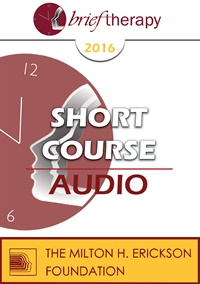
- Average Rating:
- Not yet rated
- Topic Areas:
- Short Courses | Metaphors | Utilization
- Categories:
- Brief Therapy Conference | Brief Therapy Conference 2016
- Faculty:
- Christine Guilloux, DESS Psychology
- Duration:
- 1:28:15
- Format:
- Audio Only
- Original Program Date:
- Dec 08, 2016
- Short Description:
- Among our models, our heroes, our genius and the stories that have been told to us, the ones we’ve built, the ones we’ve integrated, there are some that are deep metaphors within us. We will explore how we refer to them, how they structure and impact our lives and how we can utilize them in our therapeutic goals for inner change and help the patient build from the hero within himself/herself.
- Price:
- $15.00 - Base Price
Tags: Metaphors Utilization
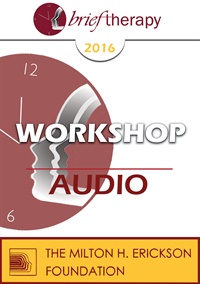
- Average Rating:
- Not yet rated
- Topic Areas:
- Workshops | Metaphors | Unconscious Processes | Brief Therapy
- Categories:
- Brief Therapy Conference | Brief Therapy Conference 2016
- Faculty:
- Connirae Andreas, PhD
- Duration:
- 2:24:50
- Format:
- Audio Only
- Original Program Date:
- Dec 11, 2016
- Short Description:
- This experiential workshop introduces a distinctive way of working with metaphor by uncovering the client’s own unconscious image of a stuck situation. Through live examples and guided practice, participants learn how spatial metaphors, direction, and movement can clarify where someone is, what keeps them there, and how small shifts can open new possibilities without interpretation or advice-giving.
- Price:
- $15.00 - Base Price

- Average Rating:
- Not yet rated
- Topic Areas:
- Special Topics | Hypnosis | Ericksonian Hypnosis and Therapy Techniques | Fundamentals of Hypnosis | Psychotherapy | Truisms | Age Regression | Hypnotic Phenomena | Post-Hypnotic Suggestion | Suggestion | Metaphors
- Categories:
- Brief Therapy Conference | Brief Therapy Conference 2018
- Faculty:
- Brent Geary, PhD
- Duration:
- 5:14:31
- Format:
- Audio Only
- Original Program Date:
- Dec 05, 2018
- Short Description:
- This workshop will provide participants with an introduction to the key concepts and techniques of practice in Ericksonian hypnosis. A brief biography of Erickson’s professional life will provide perspective on the extensive contributions he made to the fields of hypnosis and psychotherapy. Terminology of hypnosis will be explained and various approaches to induction will be described and demonstrated. The process of a typical hypnotic session will be outlined. Considerable attention will be afforded the hypnotic phenomena, the essential mechanisms in hypnotic therapy. Erickson’s landmark concepts of utilization and indirection will be explored with particular focus on the use of therapeutic anecdotes and metaphors.
- Price:
- $15.00 - Base Price
Credit available - Click Here for more information
- Average Rating:
- Not yet rated
- Topic Areas:
- Workshops | Brief Therapy | Evocative Communication | Metaphors | Strategic Therapy | Utilization | Psychotherapy
- Categories:
- Brief Therapy Conference | Brief Therapy Conference 2018 | Online Continuing Education
- Faculty:
- Jeffrey Zeig, PhD
- Course Levels:
- Master Degree or Higher in Health-Related Field
- Duration:
- 1:45:53
- Format:
- Audio and Video
- Original Program Date:
- Dec 07, 2018
- Short Description:
- Three evocative orientations to psychotherapy, utilization, using metaphor, and strategic development, will be explained, demonstrated and practiced. There are components to each of these methods that will be addressed.
- Price:
-
Sale is $29.00
price reduced from Base Price - $59.00
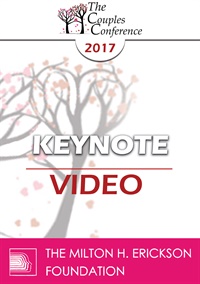
- Average Rating:
- Not yet rated
- Topic Areas:
- Couples Therapy | Keynotes | Experiential Therapy | Evocative Communication | Metaphors
- Categories:
- Couples Conference | Couples Conference 2017
- Faculty:
- Jeffrey Zeig, PhD
- Course Levels:
- Master Degree or Higher in Health-Related Field
- Duration:
- 55:49
- Format:
- Audio and Video
- Original Program Date:
- Mar 31, 2017
- Short Description:
- When information and advice fail to promote change, an experiential approach can foster adaptive realizations. Learn nonverbal and metaphoric methods to enliven your approach.
- Price:
-
Sale is $29.00
price reduced from Base Price - $59.00
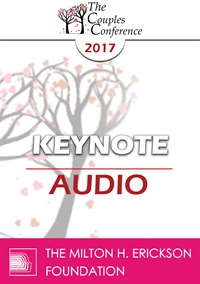
- Average Rating:
- Not yet rated
- Topic Areas:
- Couples Therapy | Keynotes | Experiential Therapy | Metaphors | Evocative Communication
- Categories:
- Couples Conference | Couples Conference 2017
- Faculty:
- Jeffrey Zeig, PhD
- Duration:
- 55:49
- Format:
- Audio Only
- Original Program Date:
- Mar 31, 2017
- Short Description:
- When information and advice fail to promote change, an experiential approach can foster adaptive realizations. Learn nonverbal and metaphoric methods to enliven your approach.
- Price:
- $15.00 - Base Price
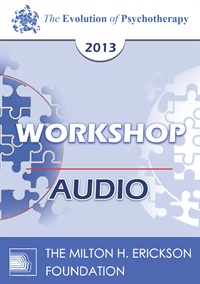
- Average Rating:
- Not yet rated
- Topic Areas:
- Workshops | Metaphors | Pain and Healing | Psychotherapy | Resources
- Categories:
- Evolution of Psychotherapy | Evolution of Psychotherapy 2013
- Faculty:
- Robert Dilts, BA
- Duration:
- 2 Hours
- Format:
- Audio Only
- Original Program Date:
- Dec 15, 2013
- Short Description:
- The late Gabrielle Roth, founder of the 5 Rhythms movement practice, was a quintessential woman of the body and sometimes called an “urban shaman.” Gregory Bateson was an iconic man of the mind and a foundational contributor to most modern methods of systemic therapy. Bateson and Roth interacted at Esalen in the legendary times during the late 1970s and Bateson encouraged Roth to bring her creation into the world. This workshop will explore the work of these two pioneers and how to integrate movement and mind to create generative resources for change and healing.
- Price:
- $15.00 - Base Price
Credit available - Click Here for more information
- Average Rating:
- Not yet rated
- Topic Areas:
- Workshops | Experiential Therapy | Metaphors | Psychotherapy | Therapist Development | Evocative Communication
- Bundle(s):
- Learning Track - EP17 Erickson Stream
- Categories:
- Evolution of Psychotherapy | Evolution of Psychotherapy 2017 | Evolution of Psychotherapy Erickson Learning Track | Online Continuing Education
- Faculty:
- Jeffrey Zeig, PhD
- Course Levels:
- Master Degree or Higher in Health-Related Field
- Duration:
- 2:20:46
- Format:
- Audio and Video
- Original Program Date:
- Dec 17, 2017
- Short Description:
- Patients change by virtue of the experiences that they live. Therapists can use advanced techniques including verbal and physical metaphors. Lecture, demonstration and practice.
- Price:
-
Sale is $29.00
price reduced from Base Price - $59.00


